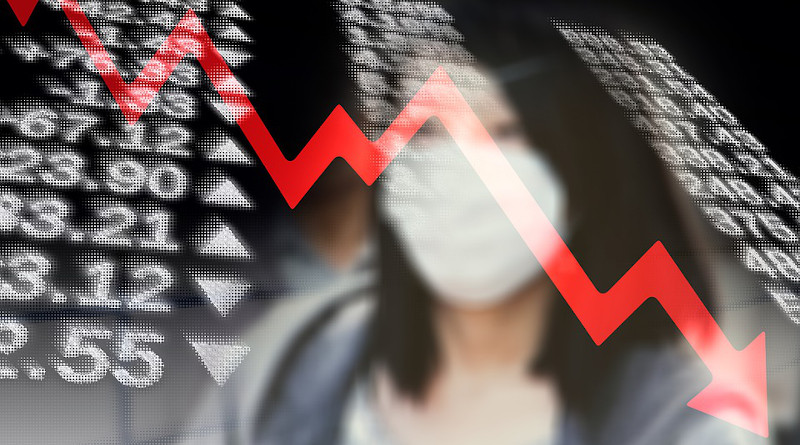COVID-19 And the Global Economy – Analysis
By Observer Research Foundation
By Alexis Crow
At the start of 2020, 126 months into the longest economic expansion in US history, investors and executives quietly asked: “How long can this keep going on? What will finally tip us into recession? How deep will it be? Where will it come from?” Indeed, with the coronavirus outbreak sweeping across the globe, financial markets shedding trillions of dollars within one week, and the yield on a US 10-year note below 1%, many are braced for a recession.
Let us think beyond financial markets for a moment, and consider economic activity. Prior to the outbreak of coronavirus, the manufacturing output (PMI) of many of the world’s largest exporters was in contraction mode for 2019. As a result of the uncertainty surrounding trade tensions, PMI in countries such as Japan, Germany, and South Korea severely waned, and global manufacturing PMI slipped below 50% – officially marking contraction – in 2019. Amidst this downturn in ‘old industrial’ and goods-producing activity, services and consumption have propelled global economic activity forward, making up the bulk of job creation and wage gains in emerging and advanced economies alike, as well as fuelling markets and returns.
With coronavirus hitting at the epicenter of consumption – in China and across Asia – economic activity in these growth sectors is brought to a standstill. Even despite some rosy, market or shareholder – quelling statements about activity resuming in COVID-hit countries, as well as robust government stimulus measures, it is likely to be a painfully slow return to anything near previous levels of productivity, output, and hence the purchasing power which fuels consumption.
One might argue that the COVID-19 hit has revealed the extent to which previous claims of deglobalization have been exaggerated. Firstly, in terms of supply chains, China has acted not only as an aggregator of regional trade surpluses (gathering inputs from other countries such as Japan and South Korea and exporting the final value added product), but also as a contributor of raw materials, as well as management oversight, to value added products. Even despite the trade war, many US and global companies have relied upon China as a source of components for final products.
Accordingly, as a result of the outbreak, many companies are focused on the immediate short-term needs of diversifying supply chains from virus-hit regions, and fulfilling orders. The cost of this latest diversification or ‘rejigging’ of supply chains is material. In a post-Great Financial Crisis world, in which many companies have failed to regain pricing power with their customers – and have delayed or postponed tariff-related cost increases – some may have no choice but to raise prices, and thus may fear losing a part of their consumer base.
This takes us to the perhaps more dire part of the outlook. While some observers have sanguinely offered a depiction of a ‘V-shaped recovery’, and only mild impact of COVID-19 on markets and the economy, the implications of a pandemic are such that it can cause demand shock. Even despite accommodative monetary policy and commitments to maintain a dovish stance by central banks around the world, lower interest rates cannot stimulate people to engage in economic interactions.[1] The fear of contagion is likely to inhibit people from engaging in hospitality and services-related activity for a prolonged period of time. And it is worth highlighting that even if the US feels to be more isolated from the epicenter of the outbreak, S&P 500 companies receive approximately 43% of their revenue from overseas – with Asia as the largest growth category, at 8.24%, with Europe just behind.[2] In a global world, no country or company is an island – and many in the US will continue to rely on demand from their services from crisis-hit regions.
Amidst panic, it is important to remain grounded in objective facts – and, where possible, to remain visionary about the future. While COVID-19 may cause a severe dislocation in the markets for the short to medium term, how do executives view the outlook for long-term growth? Which themes hold conviction over the long term, and can act as a guide for capital allocation – and perhaps even a profit amidst a downturn? For services and consumer companies, what range of product categories can be flexibly oriented toward customers amidst a downturn? For alternative asset investors – including infrastructure, real estate, and private equity, where – and when – might a dislocation in local currency markets offer an opportunity for investment for long-term returns?
[1] It should also be noted that delaying the path toward monetary policy ‘normalisation’ as a result of COVID-19 will likely add to macroeconomic imbalances and vulnerabilities, including the pile-up of non-financial corporate debt, European banking fragility, untenable fiscal situations in some advanced economies, and a deeper levering of debt-stressed households in advanced economies.
[2] https://us.spindices.com/indexology/djia-and-sp-500/sp-500-global-sales

